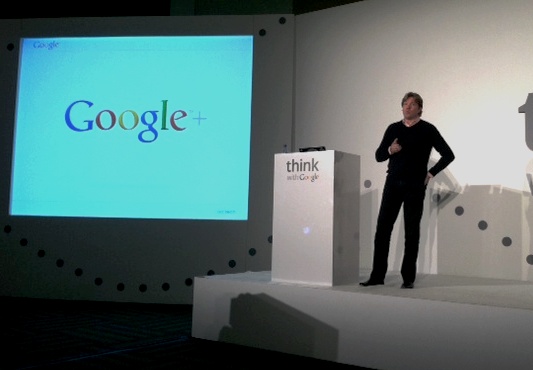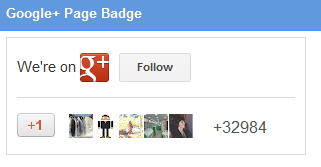Still finding your footing with Google+ as part of your social media marketing and SEO mix? You’re not alone. Marketers are struggling to capture the interest of Google+ users who tend to spend just 3 minutes on average on the site (compared to an hour on Pinterest). Moreover, +1’s on business’ brand Pages versus websites versus search ads don’t always seem to surface when expected.
At this week’s ad:tech San Francisco, the Think With Google team offered businesses insights on how to get the most out of Google+ marketing and Rikard Steiber, Google’s director of mobile and social ads, explained why the network deserves to be part of your marketing mix.
Why you should care about Google+ marketing: An internet marketing layer versus a social destination
The first step to realizing the potential of Google+ as a web marketing tool is understanding it isn’t meant to be treated like other social networks. Instead of a social destination, marketers have to think of Google+ as “a social thread” that can tie together their presence online.
 When done right, “Google+ can become your business identity on the web: +1’s can surfaces across your site, desktop search ads, mobile ads and more,” Steiber said.
When done right, “Google+ can become your business identity on the web: +1’s can surfaces across your site, desktop search ads, mobile ads and more,” Steiber said.
Winning +1’s across your online campaigns is a good way to tap into inherently social human nature. “Social is core to human behavior, and it’s also core to web behavior,” said Steiber. He referenced data indicating 71 percent of consumers say reviews from friends and family members influence their purchase decisions. When you combine this with the fact that 84 percent of consumers use online sources to research purchases, +1’s across digital marketing campaigns can help surface recommendations at the critical moment of commercial intent. (For more on Google’s premise that marketers need to catch consumers at “moments that matter,” check out Brafton’s coverage of its related ad:tech San Francisco presentation, “Making the Web Work for You.”)
Steiber’s statistic about consumers’ interest in purchase recommendations pairs nicely with a recent Zuberance study, which found that virtually all people recommend brands online through social actions. More than one-third (38 percent) are likely to recommend up to nine brands. But are they recommending them on Google+ through +1’s?
While the network has a meager 100 million users, compared to Facebook’s more than 800 million, Google claims the +1 button drives around 2.7 billion shares each month. This activity doesn’t necessarily mean people are spending time on Google+, but that’s not necessarily the point, according to Google.
“Google+ can become your business identity on the web.”
Rikard Steiber, Google’s director of mobile and social ads
Steiber alluded to the idea that Facebook Likes are present exclusively on the social network or on a business’ specific content pages, but Google +1’s have real reach. Google +1 data shows up on the network and on websites, but it also appears in the search results – paid and organic – that users access daily. Logged in users can see +1’s specifically from friends, and aggregate +1 data can also add some social clout to a website’s presence in SERPs. (Not that Google is trying to compete with Facebook, Stebier said, suggesting his comment served to emphasize that the two networks are “doing something completely different.”)
Google+ may not have the drawing power of other networks as an online destination, but having a Google+ presence and +1 options help businesses build visibility in search. This is vital as Google’s search engine is still far and away the market leader, fielding more than 66 percent of queries on the web. Plus, Brafton has reported that 89 percent of consumers turn to search engines for shopping decisions, making search the No. 1 channel influencing purchases.
How you can make Google+ marketing work for your business: Six tips for Google+ success
In order to drive the strongest search, social and overall lead generation results from Google+, the Think With Google team offered some simple tips, and here are Brafton’s takeaways.
1. Create an official brand Page.
It’s a basic step, but one that shouldn’t be overlooked. At the start of 2012, 77 percent of the top 100 global brands had Google+ pages, but many businesses have yet to come around to Google+ marketing. According to the recently released Social Media Examiner 2012 Industry Report, just 40 percent of marketers are currently using Google+. Developing a Page and presence now can still offer some early adopter advantages, as 67 percent of companies plan to increase Google+ investment and activity throughout the year.
As Steiber said, having a page is good practice for building your online identity, and you should verify your page so prospects and customers can trust that it’s your brand’s content and ideas being shared.
Marketers looking to build their personal Google+ pages should use a personal Gmail account instead of a business app account. Much to the chagrin of ad:tech attendees, Steiber indicated there are “no plans in the immediate future” to allow users with a personal account and a business app account to merge their Google+ presence.
2. Make your page lively.
Google is giving businesses the chance to create highly visual, interactive pages. The Think With Google team pointed to the Android Page as a prime example of this. The Android Google+ Page uses animated GIFs in its banner, and the team notifies connections when the banner photos are updated. As Steiber pointed out, the images win +1’s just for being cute and interactive.
3. Use hangouts.
Hangouts are ideal for “getting bigger faster,” said the Think With Google Team. They can be used for product launches, building brand awareness and/or developing loyalty and retention among existing customers.
Before launching a Hangout, it’s important to get comfortable with the various Hangouts features. Google offers a video tutorial of Hangouts, and it seems new features are being added every few weeks. (Recently, the company added a feature that lets users make outbound calls in addition to “hanging” with people in the Google+ ecosystem. Read more at CNET.)
Google offered some additional insights based on Hangout successes and failures:
- Use a wired connection instead of Wifi. Losing connectivity is a surefire way to turn prospects off.
- Run through your session in advance. Even though Hangouts should include “magic moments” of spontaneous interaction with customers and other attendees, you want your business to come off as professional and polished.
- Pick a company ham to host your Hangout. It’s important to strike the balance of choosing a knowledgeable employee and a personable employee. This is a chance to literally put a face on your brand, so you want to pick someone who will be exciting for attendees.
4. Link your Google+ page to your ads.
You don’t want your +1’s to live in separate silos: You want them to surface any time users search for pertinent information. Marketers have had the opportunity to get +1’s on their ads since last fall.
They should also take advantage of the Social Extensions tab in AdWords accounts to connect their brand pages to their search ads.
Google explained:
“For campaigns that don’t have Social Extensions enabled, your AdWords ads only show +1’s from people who have +1’d that ad’s landing page. This limits the likelihood that someone who sees your ad will have a friend or contact who’s recommended it. By enabling Social Extensions on your ad campaigns you’re able to leverage all the +1’s your brand has received, whether it be on a search result, on your Google+ Page, your website or on your ads, making it more likely that someone who sees your ad will have a friend or contact who has recommended it.”
Learn more about how sync your Page with your search ads on Google’s AdWords Support Page.
5. Add a Google+ badge to your website.
Much like adding your Google+ Page to your ads, you can integreate a Google+ badge on your site to indicate your website has an affiliated brand Page.  This helps Google consolidate +1’s from your website and your Page, and deliver them more seamlessly to users.
This helps Google consolidate +1’s from your website and your Page, and deliver them more seamlessly to users.
Connecting your site to your G+ Page can result in recent Google+ posts appearing under your website in search results (giving you more SERP real estate for branded queries), as well as integration of your brand’s Google+ activity on related Maps searches.
If you’ve already got the +1 button on individual content pages or articles, you can leave it in place and add the badge. Notably, the badge also makes it easy for visitors to add your company to their circles. Google explains how to implement the badge in its Developer Support Page.
6. Measure the impact of recommendations on your bottom line.
As Google said at last month’s SES New York conference, “Investment in social marketing can’t be faith based. It must be rooted in understanding of the economic value.” Google’s ad:tech representatives affirmed this.
In AdWords, marketers can segment their ads based on +1’s to measure the impact of social referrals. Google claims that the presence of +1’s increases CTR by 5 percent to 10 percent on average for paid search ads.
“Investment in social marketing can’t be faith based. It must be rooted in understanding of the economic value.”
Marketers can also take advantage of the new Social Reports available in Google Analytics to understand how specific Google+ interactions around their content enhances their search goals and overall business objectives thanks to the Social “Assisted Conversion” tool. Brafton covered Google’s tips from SES on how to use the Analytics Social Reports to boost your bottom line. The feature is expected to roll out to all Analytics users in the coming weeks.
Social Media Examiner reports that 70 percent of marketers want to learn more about Google+ this year, and these insights from Google will hopefully serve as a good starting point to making the platform work better for businesses. For more information, check out Brafton Social Manager Meagan Parrish’s related blog post full of tips for results-driven Google+ marketing.


